Trello vs Wrike: Two Big Names Battle It Out in 2026
Wrike and Trello are two well-known kanban-based project management solutions. Join us as we compare Trello vs Wrike to see which one is the best choice for you and your business.
If you’re shopping around for a project management tool for your business, the names Wrike and Trello are bound to come up, especially if you’re in the market for a kanban-based tool. In this Trello vs Wrike battle, our project management experts will compare the two, so you can see which one will best suit your needs.
The short answer is that both will give you the ability to run relatively simple operations on their free plans alone (see them on our list of the best free project management software), making them perfect for small businesses on a tight budget. However, if your needs surpass that of a kanban board, Wrike becomes your choice by default; Trello’s extended capabilities are no more than okay.
That said, as much as Wrike dominates Trello in some key areas, it can’t keep up with the top echelon. For example, Wrike bit the dust against monday.com — our favorite cloud-based project management tool — in our monday.com vs Wrike piece. It also lost out in our Asana vs Wrike article. It just goes to show there’s always a bigger dog (read our best project management roundup for more).
| Features | ||
|---|---|---|
| $5 / month(All Plans) | $10 / month(All Plans) | |
| Review | Review | |
| Kanban board | ||
| List | ||
| Calendar | ||
| Timeline | ||
| Spreadsheet view | ||
| Gantt charts | ||
| Workload planning | ||
| Long-term planning | ||
| Multiple project management | ||
| Dependency management | ||
| Native scrum management | ||
| Set user permissions | ||
| File storage | ||
| Time-tracking | ||
| Built-in integrations | ||
| Reporting features | Yes, via power-ups | |
| Free plan | ||
| Free Trial | 14 days | |
| Web app | ||
| Windows | ||
| MacOS | ||
| Android | ||
| iOS | ||
| AI Tools | ||
| Ticket-based support | ||
| Tutorials | ||
| Knowledgebase | ||
| Forum | ||
| Live chat | ||
| Phone support |
Setting Up a Fight: Trello vs Wrike Project Management
We’ll be comparing Trello vs Wrike over the course of five rounds, with each round giving a point to one service or the other. However, this isn’t a full comparison that goes into every detail. To save space, we’ll only go over the most salient points. If you need more details, we recommend you check out our Trello review and Wrike review. With that out of the way, let’s get going.
Avoid Costly Project Management Mistakes – Get Free Tips Today!

- Discover 10 fundamentals of project management
- Understand step-by-step plans for PM execution
- Learn tips to avoid 5 common mistakes by beginners
- 1
- 2$10 / month(All Plans)
1. Features
When it comes to what project management software can do, there’s no real contest between Wrike and Trello: Wrike wins, hands down. While we like Trello a lot thanks to its excellent kanban board, that’s really all it has. In contrast, Wrike can do a lot more than just move cards around, and it scales up a lot better than Trello does. Let’s see what we mean by that.
Kanban Task Management
We’ll start with Trello. As we almost always point out (our Trello vs monday.com article being a case in point), it stands and falls with its kanban board. It’s Trello’s main feature, and in a way, its only feature; everything else is just there to support the main board. As a result, it’s probably one of the best kanban boards out here.
No other project management software solution handles kanban concepts as well as Trello does. Not only is it easy to move lists and cards around, but you can also tweak a ton of settings, add details to tasks and then place filters for easy sorting and retrieval.
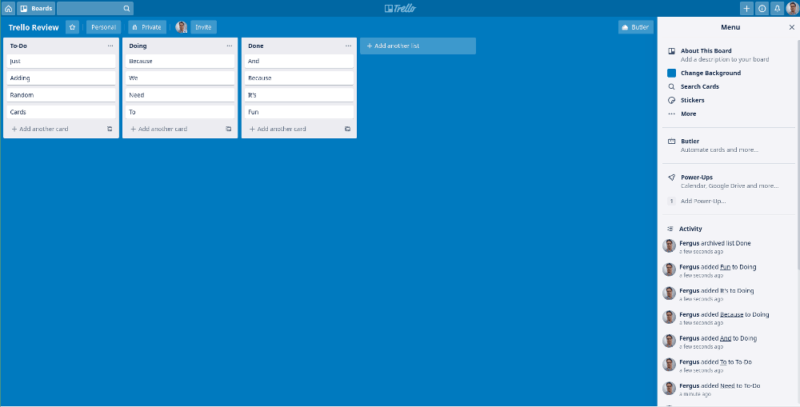
As a bonus, because it’s so simple, it’s also virtually idiot-proof. This means that team members will be able to get to work with it quickly and usually without errors. We use it ourselves at Cloudwards, and although we have come up against its limits a few times, it has stood us in good stead for years now.
The trick to using Trello successfully is recognizing those limits, though. You can use add-ons — called “power-ups” — to add some oomph, but as we discuss in our Trello pricing article, that doesn’t work all that well. A recent update added some extra views — including charts and a calendar — but nothing that can go up against Wrike’s abilities.
Overall, it’s probably best to use Trello as a kanban board and, if you need anything beyond that, switch to another piece of project management software, like Wrike.
Project Management, the Wrike Way (Wrike Kanban)
Wrike also has a kanban board, and a good one at that. We even like it more than that of our otherwise favorite, monday.com (read our monday.com review for more on its kanban board).
Wrike’s board is big, with lots of room to move around in, and the cards are large and easy to drag and drop. For this reason, it’s the best Trello alternative, if the Kanban board is your go-to feature.
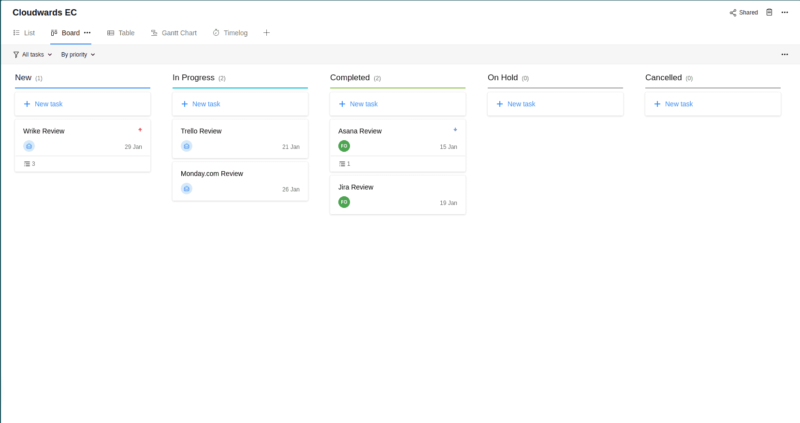
However, Wrike has more on offer than boards, lists and cards. You also have a list view and a table view, neither of which we’re crazy about (read our Asana review for a service that handles these better).
Wrike also gives you Gantt charts, which come in handy when dealing with tasks that are dependent on each other. Though Wrike doesn’t go as far as a dedicated tool like TeamGantt does (read our TeamGantt review) in managing task dependencies, it does a fine job.
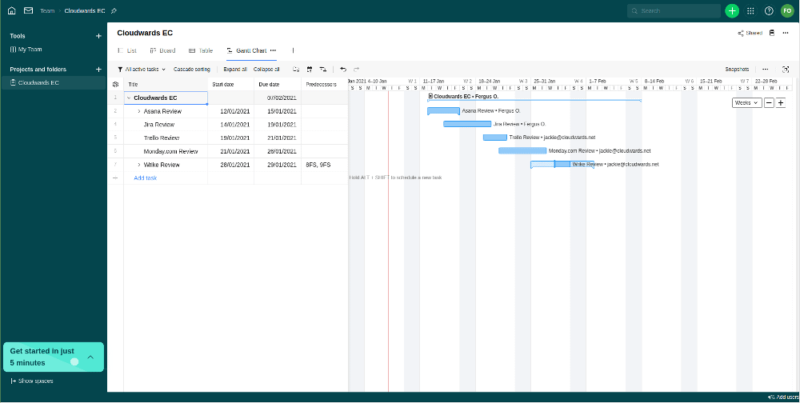
Wrike vs Trello App Integrations
We won’t even go into the more advanced features Wrike offers, as that would just be kicking project management software when it’s down. Wrike is clearly the better of the two out of the box. However, there’s still a case to be made for Trello, thanks to its power-ups.
We’re not huge fans of Trello power-ups here at Cloudwards because their quality can’t be guaranteed. Plus, they can make Trello even more pricey — but more on that in the next section. However, a savvy user could combine Trello’s free plan with another service’s free plan and create a double whammy that doesn’t cost a penny.
A couple of examples are putting TeamGantt’s Gantt charts into Trello or using some of Asana’s free features to bolster Trello a bit (read our Asana vs Trello comparison for more information on that). Depending on your circumstances, you could probably think up a few of your own, like adding time tracking or an activity stream. Wrike allows add-ons, but nowhere near this flexibility.
Mobile Apps
Both Wrike and Trello offer mobile apps for iOS and Android, with both being useful to keep up with tasks or make a quick note; neither is able to replace the desktop or web app. However, Wrike’s is a little better, even if only because its list view is better suited for use on a small screen than a kanban board is, so we’ll give it the win here.
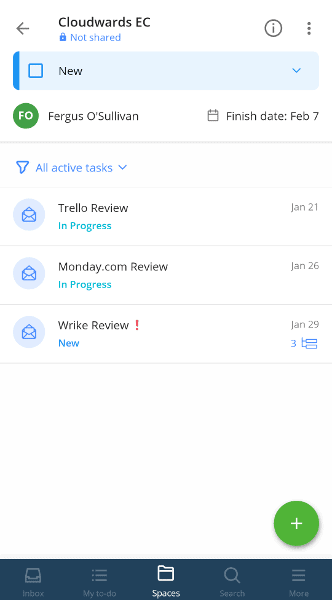
2. Price
One round down, and Wrike scores the first point of the battle. We would like to say Trello goes for an equalizer here, but looking at the feature package it offers and the subscription fees it demands for its paid plans, Wrike is once again the winner. Wrike pricing is all that hot, but for practically the same money, you get a lot more, as you can see for yourself.
How Much Does Trello Cost?
- Unlimited users, 10 boards, Unlimited power-ups, Unlimited storage
- Price is per user, Unlimited boards, Custom fields, Invite guests
- Price is per user, Several new views
- Price is per user, Advanced admin & security settings. Discounts for larger teams.
How Much Does Wrike Cost?
- Unlimited users. Basic features.
- Price is per user. Plans for 5, 10 and 15 users.
- Price is per user. No monthly option. Plans for 5 to 200 users.
More plans
- For large teams; Enterprise-grade security and scalability; Plans for 5 to an unlimited number of users.
- For teams with complex work needs; Advanced tools and analytics for complex work; 5 to unlimited users
For the purposes of this comparison, we’ll leave Wrike’s Business plan and Enterprise plan out of the equation, as those offer features Trello doesn’t. You could make a case to compare Enterprise plans, but that’s a little out of our bailiwick, so we’ll skip it, as well. Those plans are geared toward large corporations, and we’re not qualified to speak to them.
Trello’s Premium plan and Wrike’s Professional plan are pretty comparable price-wise, but Wrike’s is slightly better. While we like Trello’s newly added features, Wrike is more fleshed-out and get more done.
In fact, we’re not sure why you’d pay for Trello at all, as you’re basically paying $10per user per month for a kanban board plus some extra features of dubious benefit. Wrike offers a similar board, plus a bunch of other features (including the Gantt chart) for the same price, making it a better deal.
Though you could make a case that the power-ups are what make Trello, many of the best of them require you to pay for them separately. While this does make Trello more versatile, it also makes it a lot more expensive and, as such, the round goes to Wrike.
3. Ease of Use
Two rounds down, and both have gone to Wrike. Though Trello will rally in this round and score one point for ease of use. When it comes to user-friendliness, Wrike isn’t bad, but Trello is just that bit smoother and easier to use. To a certain extent, this comes down to Trello being the simpler program, but there’s more to it than that.
With kanban, simplicity is the name of the game. In the end, it’s just the dragging and dropping of cards among columns. Trello has embraced this philosophy and remains simple throughout. Almost all functions are steered from the main screen.
Also, if you need to add details to a task, you just click the card and up pops a handy overview where you can mess around all you want (read our Jira review for a service with a similar way of doing things, and see how it compares with Trello in our Trello vs Jira article).
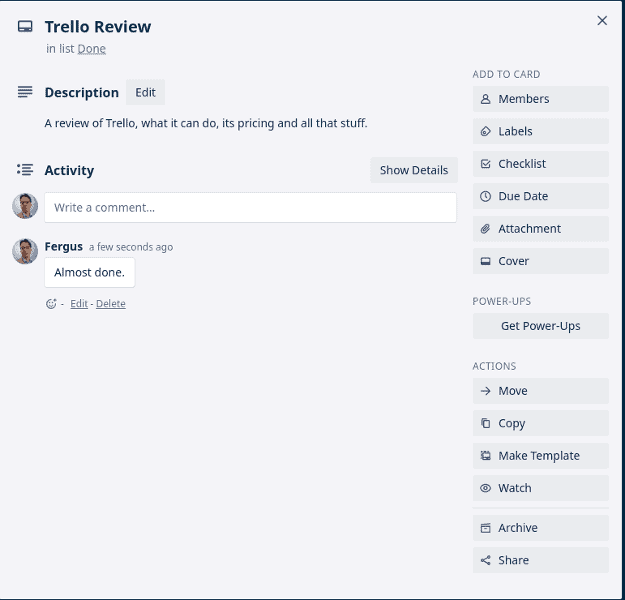
The only time you ever need to leave the main screen is for the options; everything else is just right there, including the ability to filter cards, assign tasks to team members, you name it. This makes for quick and easy project planning, and we just love it.
Trello vs Wrike: Shortcomings
However, it does have its shortcomings when compared to Wrike. Since its competitor in this article can simply do a lot more, there are a few shortcuts you can take with Wrike that Trello can’t, like ranking the importance of projects and tasks. Overall, Wrike handles these things in a user-friendly manner, but not always.
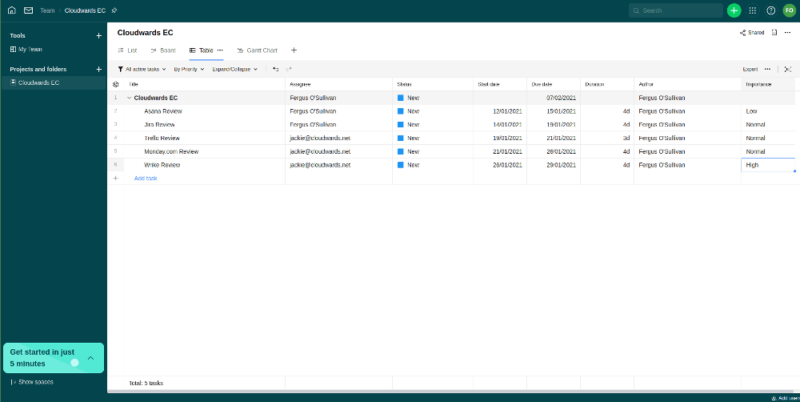
One thing that gets a little annoying with Wrike is how you have to often double back to the dashboard to get an overview. While you can navigate between projects pretty easily from the right-hand bar, other movements — like those involving oversight and reports — mean a trip to the dash. It’s not a huge deal, but it can get a bit annoying and costs Wrike the round. Refer to the best Wrike alternatives to for more options.
4. Security & Privacy
The score is two to one, but in this round, Wrike will strike the finishing blow. While neither service offers the greatest privacy — in fact, we wouldn’t recommend either in this respect — Wrike does offer good security, giving it the point it needs to tip the balance.
Let’s first get the security bugbear out of the way: neither Trello nor Wrike are exactly careful with your data, making it clear in their privacy policies (Wrike’s and Trello’s) that they gather details on your activity. They then use this for their own marketing as well as sharing with third parties. The data gathered is fairly basic, but still…
Security is better, though. Trello and Wrike both use TLS in transit and encrypt data at rest, using AES-256. The reason Wrike gets the win is that it uses in-house servers, while Trello stores data with AWS. Although AWS is decent, its leaky buckets are a little too common for us to go so far as to recommend the service.
5. Customer Support
With that, we come to the last round, which is a rare tie. Both Trello and Wrike both take excellent care of their customers. Customer service with both consists of an excellent knowledgebase, great starting tutorials as well as a large forum filled with people raring to help, both paid and volunteers.
More direct customer support comes in the form of an email with Trello, while Wrike offers both email and chat. Responses with all these usually come down to a link to a relevant page in the knowledgebase or forum, but the answers come quick, and you get the ability to follow up, if necessary. Overall, a good experience with both.
The Verdict: Wrike vs Trello Comparison
Wrike and Trello are both excellent free project management tools that let you manage projects without hassle. While we love Trello for its ease of use and simple layout, for anything more than just a kanban board, Wrike is the clear winner. It lets you manage multiple projects across multiple views and offers better value, to boot.
Winner: Wrike
However, both offer a free version, so there’s nothing keeping you from trying them out for yourself and seeing which is the better fit for you and your business processes. Let us know how that goes for you in the comments below. As always, thank you for reading our Wrike vs Trello comparison.
FAQ
It depends on what you need it for, but overall, we would say Wrike is the better choice. However, both come with free plans so we recommend you give them each a spin and see which one you like best.
Generally speaking, among project management tools, we’ll rank monday.com, Asana and Wrike higher than we do Trello.
Trello is great for managing projects, as long as the projects being managed are simple. For more complicated things, Trello falls a bit short.


